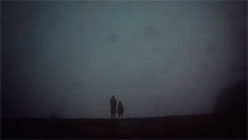The full-color prints by the California-based photographer Todd Hido at Stephen Wirtz Gallery depict decaying and deteriorating suburban developments and the mysterious people inside them. Last year, Hido’s Fragmented Narratives at Bruce Silverstein Gallery in New York featured some of the same works, and Excerpts from Silver Meadows resumes his atmospheric surveillance of American culture. The images are personal and somber and, as a suite, the sequenced photographs suggest isolation, terror, and an impending slow, silent destruction.
Hido, who trained with the photographer Larry Sultan (1946-2009) at California College of the Arts (CCA), has been compared to the filmmaker David Lynch for a tendency toward strangeness as well as to the writer Raymond Carver for haunting depictions of hardscrabble struggles in America. In fact, in 2009, Hido’s lucid, luminous pictures of suburban houses at night — his most popular body of work — appeared on the Vintage Contemporaries softcover backlist celebrating Carver’s twenty-fifth anniversary. But the painterly shrouded trucks, tract homes, and desolate highways in Excerpts from Silver Meadows, created between 1996 and 2011 in Hido’s childhood home of Ohio, might be more aptly placed on the covers of Cormac McCarthy’s novel The Road (Knopf, 2006) or Robert Kirkman’s comic book series The Walking Dead (2003-present). Hido doesn’t so much engage his own childhood landscape as encounter it from inside a car, and the results recall the pictorialist images of Alfred Steiglitz.
This exhibition presents a gray, dusky world of neglect and disaster. In Untitled #10695 (2011), two figures stand at the top of a crest; skeletal treetops pierce a ghostly darkness. In Untitled #6349 (2008), a collapsed oak lies in the arm-like branches of nearby trees, its own roots exposed; a field of brown grasses, recalling Andrew Wyeth’s Trodden Weed (1951), seems dead, lifeless. And, as if fleeing an unknown horror, a black crow descends onto a flat, snow-crusted bank in Untitled #1019 (2011). The landscapes suggest cataclysmic events or a strange dreamlike descent among a population.
Hido creates his landscape images from behind a blurred windshield, using a field camera and natural light; droplets of moisture create a transportive, hallucinatory sheen. A frozen body of water in Untitled #10253 (2011) suggests the bleak, despairing awe a child might experience while alone at a riverbank’s edge or some ruined lake of the future. The straight and slender cables of utility poles in Untitled #9198 (2010) magically fade along an empty and unraveling highway; only the presence of lonely tire tracks in the snow signals that others have been there.

Untitled #8906, Todd Hido, 2009. Courtesy of the Artist and Stephen Wirtz Gallery, San Francisco.
Spread throughout the galleries are portraits of “broken starlets in suburban dress.”1 Although these figures are present within each chapter of the exhibition’s story, these staged and stylized images interrupt an otherwise unified, serious, and savage narrative. That said, Untitled #8906 (2009) — in which a young woman in a flesh-colored bra stands against a plywood wall, appearing like a survivor in a newly brutal world — does fit into the bleak universe of the landscapes. The subject’s startled, sensual isolation evinces the social documentary embedded within the series.


